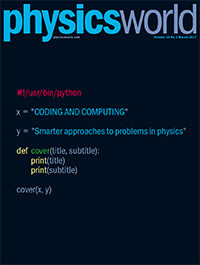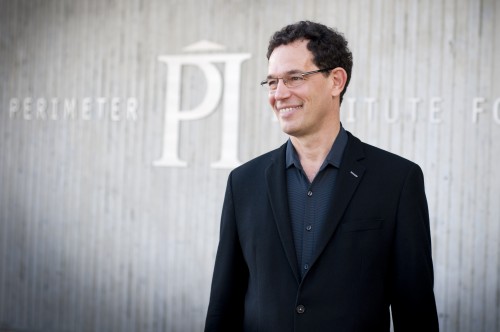Tag archives: dark matter
Happy Dark Matter Day
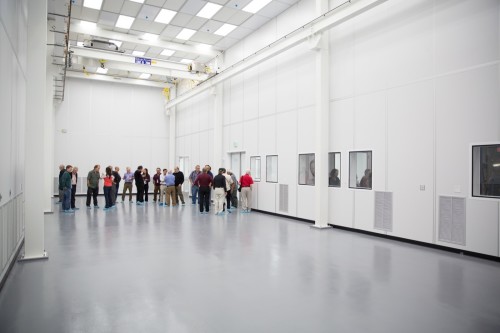
Darkness to light: the LSST clean room (Courtesy: LSST)
By Hamish Johnston
“On and around October 31, 2017, the world will celebrate the hunt for the unseen…” is the message on the Dark Matter Day website, which has been put together by physicists at universities and research labs across the globe. The site has links to more than 100 online and real-life events taking place in October and November of this year in more than 20 countries worldwide.
Why celebrate dark matter? Why not? After all, the elusive dark stuff appears to account for about 85% of the matter in the universe and its gravitational pull defines the fabric of the cosmos at galactic and greater distance scales. Furthermore, working out exactly what dark matter is could provide valuable information about physics beyond the Standard Model.
View all posts by this author | View this author's profile
So you want to know about the dark universe?
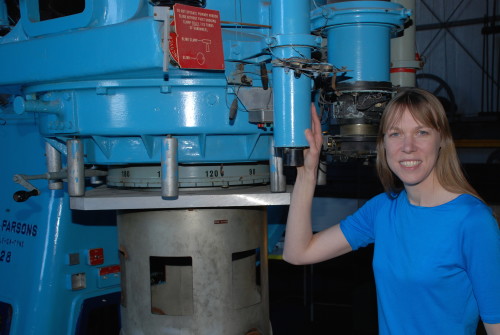
Big thinker – Catherine Heymans is an observational cosmologist at the University of Edinburgh and author of the new Physics World Discovery ebook The Dark Universe.
By Matin Durrani
It never ceases to amaze me that we know almost nothing about 95% of the universe. Sure, the consensus is that 25% is dark matter and the rest is something dubbed “dark energy”, but beyond that our knowledge is wafer thin.
The flip side, though, is that there’s plenty for physicists to get stuck into. And if you want to get up to speed with the field and find out more about some of its challenges, do check out a new free-to-read Physics World Discovery ebook by Catherine Heymans from the Royal Observatory, University of Edinburgh, UK.
Available in ePub, Kindle and PDF formats, The Dark Universe explains the dark enigma and examines “the cosmologist’s toolkit of observations and techniques that allow us to confront different theories on the dark universe”. And to get you in the mood for all things dark, I asked Heymans some questions about her life as a research scientist. Here’s what she had to say.
View all posts by this author | View this author's profile
Coding and computing: the March 2017 issue of Physics World is out now
Physics these days wouldn’t succeed without software. Whether those lines of code are used to control new apparatus, make sense of fresh experimental data or simulate physical phenomena based on the latest theories, software is essential for understanding the world. The latest issue of Physics World, which is now live in the Physics World app for mobile and desktop, shines a light on how some physicists are exploiting software in new ways, while others are reinventing the hardware of a computer itself – binary isn’t the only way to go.
Sometimes there are so much data that software collaboration is the best way forward. In the issue, physicists Martin White and Pat Scott describe how the GAMBIT Collaboration is creating a new, open-source software tool that can test how theories of dark matter stack up against the wealth of data from various experiments such as direct searches for dark matter and the Large Hadron Collider. And with software development being so essential for physics research, data scientist Arfon Smith argues that we need to adopt better ways of recognizing those who contribute to this largely unrewarded activity. Columnist Robert Crease explores the other extreme: whether software can be patented.
Meanwhile, in an emerging field straddling both coding and computing, researcher Maria Schuld explains how quantum computers could enhance an already powerful software approach known as machine learning. (You can also read her article on physicsworld.com here.) Further into the realm of raw computing, physicist Jessamyn Fairfield describes the quest to develop a new kind of hardware that is physically, and functionally, similar to the computers inside our very own heads. As for how our brains process information, don’t miss a glimpse into the mind of physicist Jess Wade who has created a doodle based on the work Fairfield describes.
View all posts by this author | View this author's profile
Neutrinos that go bump in the night
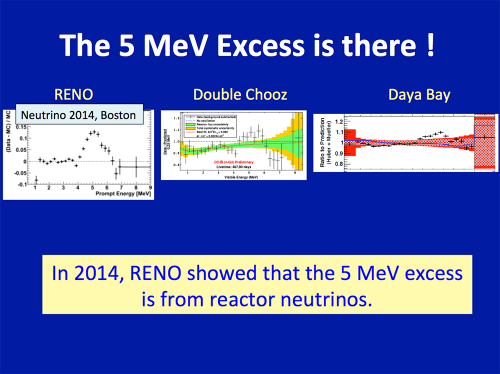
Triple bump: the 5 MeV bump data presented by K Joo at the Neutrino 2016 conference. (Courtesy: RENO Collaboration)
By Tushna Commissariat
A final mystery that was mentioned at the Neutrino 2016 I attended in London this week was yet another unexpected “bump” in data at 5 MeV, measured while monitoring the neutrino flux from nuclear power plants. Starting with the RENO experiment in 2012, it was spotted by the Double Chooz experiment in 2014 and finally by the Daya Bay neutrino experiment earlier this year. While the initial signal was not of high enough statistical significance, it has now held up over time and more measurements.
Limiting factors for the elusive sterile neutrino
By Tushna Commissariat
More data are definitely needed in the quest for the sought-after sterile neutrino. That much was clear as more than 10 different global neutrino detectors announced at the Neutrino 2016 conference in London that they have found no evidence for the slippery particle’s existence. The sterile neutrino is a hypothetical and much-debated fourth type of neutrino that would contribute mass, but only interact with the other three “active neutrinos”, making it that much more difficult to detect. In the video above, Physics World features editor Louise Mayor explains why researchers are so keen to nail down this particle, should it exist, as it may single-handedly explain some of the biggest mysteries in physics today, including dark matter.
View all posts by this author | View this author's profile
Symmetry-violating neutrinos may hold the key to antimatter

Deep trap: Inside the Super-Kamiokande neutrino detector. (Courtesy: T2K Collaboration)
By Tushna Commissariat
As you may have read, earlier this week I was at Neutrino 2016 – the 27th International Conference on Neutrino Physics and Astrophysics – in London. Although I was only at two days of the week-long conference, I still have neutrinos on my mind. A whole host of experiments presented various data and updates. Indeed, the researchers presenting the latest results from the Tokai to Kamioka (T2K) experiment in Japan and the NOvA Neutrino Experiment at Fermilab in the US had some interesting things to say.
T2K collaborator Hirohisa Tanaka, from the University of Toronto in Canada, revealed that the experiment’s most recent data seem to support earlier hints that there may be different oscillation probabilities for neutrinos and antineutrinos. If these data hold up, then it would have big consequences – the standard model of neutrino physics says that these two oscillation rates should be the same so as not to violate charge–parity (CP) symmetry. According to the collaboration, their observed “electron antineutrino appearance event rate is lower than would be expected based on the electron neutrino appearance event rate, assuming that CP symmetry is conserved”.
Cosmic messengers and the rise of neutrino astronomy
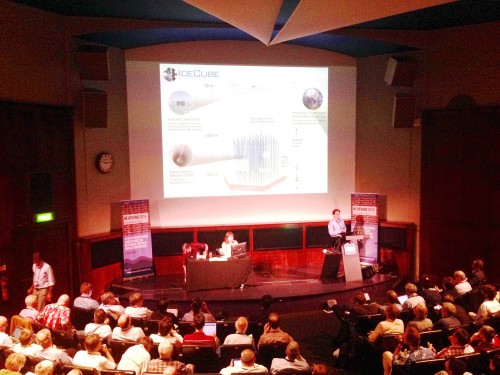
Cool operator: Marek Kowalski talking about IceCube at the Neutrino 2016 conference. (Courtesy: Tushna Commissariat)
By Tushna Commissariat at the Royal Geographical Society in London
“There are still many things to be studied in neutrinos,” said 2015 Nobel laureate Takaaki Kajita at the first talk of the Neutrino 2016 conference that began in London today. I couldn’t help but notice that his statement rang very true, as the day’s talks touched on everything from high-energy neutrinos to dark-matter searches to monitoring nuclear reactors. This year, more than 700 physicists from all over the world are attending the week-long conference, which is taking place at the historic Royal Geographical Society in London.
Why converge?
By Louise Mayor in Waterloo, Canada
Right now, top physicists from around the world are arriving in Waterloo, Canada, to attend a unique conference. Christened Convergence, the meeting is the brainchild of Neil Turok, director of the Perimeter Institute for Theoretical Physics (PI) in Waterloo, where the event will be based. I spoke to Turok to find out what motivated him to set up this conference, what makes it so special, and what he hopes it will achieve.
Busting dust deep underground in SNOLAB
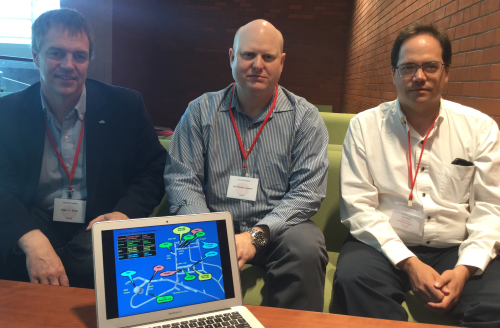
Squeaky clean: SNOLAB’s Nigel Smith (left), Ian Lawson (centre) and Chris Jillings.
By Hamish Johnston at the CAP Congress in Edmonton, Alberta
I’m a bit of a DIY enthusiast and one thing that I know about drilling into a masonry wall is that you should hold a vacuum-cleaner hose to the hole or you will end up with dust all over the wall and the floor below. Believe it or not, that is exactly what workers at SNOLAB in Canada do in order to keep background levels of radiation from affecting their dark-matter and neutrino detectors.
View all posts by this author | View this author's profile
The May 2015 issue of Physics World is now out
By Matin Durrani
A couple of years back, I had the pleasure of travelling 1100 metres below ground to visit a dark-matter laboratory at the bottom of the Boulby Mine on the north-east coast of England. The journey was certainly memorable – it involved plunging down in a rattling lift cage for several minutes with a group of miners setting off on their morning shift. Once in the lab – housed inside a souped-up set of trailers – I interviewed physicist Sean Paling about the experimental projects going on there.
Setting up an underground lab, like that at Boulby, certainly doesn’t come cheap and in recent years, many have started to diversify into new areas. In the May issue of Physics World, which is now out in print and digital formats, Paling and his colleague Stephen Sadler – who is director at DURRIDGE UK Radon Instrumentation – describe the renaissance in the science taking place far beneath our feet. Studies in underground labs now range from Mars rovers to muon tomography and from radioactive dating to astrobiology.
